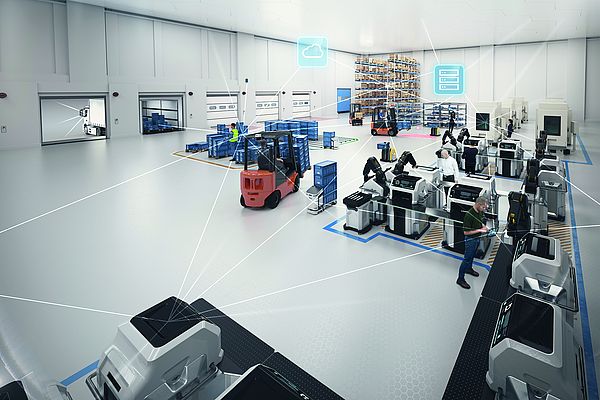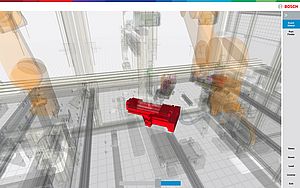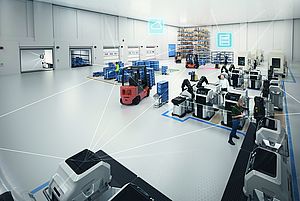Many factors influence the competitiveness of a company nowadays. The degree of innovation at the plant level, the visibility on the global market, the ability to provide not only cutting-edge systems but complete solutions to increasingly demanding customers.
But where does Logistics stand in the ranking of a company’s priority today, on a scale from 1 to 10? ‘’I would rank Logistics 4.0 at 9 or even 10. Machine performance management and condition monitoring are in full swing, and many companies have achieved considerable optimizations in terms of uptime and productivity.’’ declared Matthias Hülsmann, Vice President Connected Logistics at Bosch Connected Industry, during our conversation around these topics.
Today, many processes of the intralogistics material flow have not been automated yet and consume many resources. Bosch Connected Industry has worked a lot in the last few years to enhance user experience in intra- and extralogistics, and the company's efforts in this direction can be summarized in the Nexeed Connected Logistics solutions, developed together with production and logistics users like forklift drivers.
Digitization of material flow: Pragmatic real-time logistics
The lack of automation at an intralogistics level is a well-known issue that can dramatically impact on competitiveness. ‘’Many of our customers have realized that, in the light of more flexible demand patterns, an efficient supply chain is key. Yet, compared to many manufacturing processes, supply processes are often still performed manually, paper-based and without IT integration. Hence, both the internal and the external supply chain show great opportunities for improvement.’’ explained Mr. Hülsmann.
Logistics doesn’t only mean that the performance and delivery times are optimized, but it’s also a matter of making people’s life easier and improve daily routine for the operators involved. ‘’Missing transparency causes high stress for logistics staff, but the goal should be to enable people to perform their work without time pressure.’’ said Mr. Hülsmann.
Bosch developed a new concept, based on a pragmatic real-time approach, that is always focused on the user: ‘’Our pragmatic real-time logistics approach addresses the pain points of the user first. Whether it be for search, booking or inventory efforts, manual loading of transports or empty runs of forklifts, we say that Logistics 4.0 focuses on the creation of added value in the user story, and not only on technology.’’ he added.
On the other hand, the use of collected data can not only improve productivity but also efficiency in logistics processes. That's why Bosch Connected Industry has developed a module that can record the position and speed of intralogistics vehicles, while visualizing their routes in road maps, heat maps and efficiency diagrams. The status of the vehicles is regularly sent to the software, which visualizes it in a real-time overview for the employees.
Becoming smarter and smarter
Today, most of the companies are still undertaking the digitization process at a relatively slow pace, and even though real-time data is generated it cannot often be used to its full extent. This concerns also Logistics 4.0, for which the constant development of more and more refined IIoT solutions that automate the supply chain is fundamental.
Imagining a constant grow of smart data available and usable, the future of logistics will be based on the implementation of cobots, HMI assistance systems, and sensors for automated ID-booking and deviation managements in the supply chain. Matthias Hülsmann showed us his vision of how this grow will take place: ‘’I strongly believe that we will arrive at a tipping point where the use cases will grow to a size where real-time data flows become truly interconnected. We will see the emergence of ‘smarter’ systems, which have enough real-time data to generate structured improvement of the supply chain with autonomous learning algorithms and autonomous decision-making empowered by all kinds of new technologies like AI, neural networks, distributed legers or energy harvesting.’’
An example of how the supply chain can be digitized is Bosch’s Nexeed Track and Trace. The freight itself regularly reports where it is located. In addition, the software transmits further information on temperature and vibration to the cloud. Logistics experts know at all times where the goods are, whether they will arrive on time and in what condition they are.
In this context, IoT must be economically sustainable to become a concrete part of the companies’ digitization strategy. This is one of the reasons why Bosch Connected Industry chose a pragmatical approach that supports the major pain points, aiming to produce acceptance on user level – a key success element – and deliver a short payback time. ‘’Our IQ, or USP, is the combination of manufacturing and logistics domain know-how with IoT expertise and the mission to create practical value on the shop floor. We have set ourselves the goal of making digitization profitable right from the start – and of making it not only acceptable but really enjoyable for employees.’’ said Mr. Hülsmann.
The role of AI in intralogistics
As already mentioned, many processes in intralogistics are not automated and still need the intervention of an operator. Human workforce is therefore at the forefront of the games. That’s why it is essential to find solutions that make their life easier, before thinking about an AI strategy to replace human operators. Something that for Matthias Hülsmann is an unlikely scenario for the moment: ‘’AI will surely play an important role in our software. However, due to the huge complexity of the intralogistics ecosystem, I am convinced that human operators will not vanish completely from the shop floor or the warehouse of brownfield factories and warehouses. Their role will change, and they will be able to save a lot of time and energies.’’ he stated.
All the time spent for searching the material stored, sometimes incorrectly, the energies consumed to rush from one warehouse to the other, all the booking efforts will be reduced, but humans will still be at the heart of decision making and problem solving of the digital factory. At least for a long time, no matter how much we will teach our machines or systems…
Sara Ibrahim



















